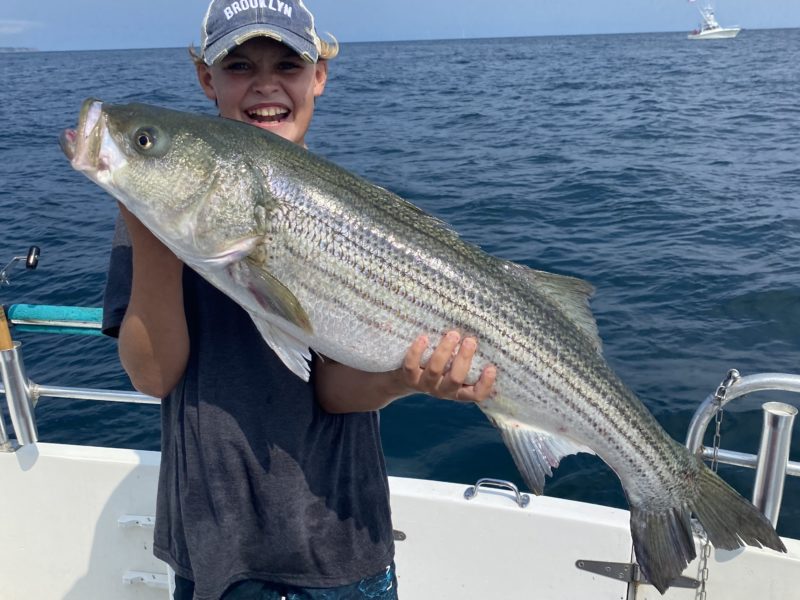

If you fish for striped bass and are not a close follower of striped bass stock and management policy, you should watch the American Saltwater Guides Association explainer about the upcoming striped bass management plan update process.
The discussion was hosted by the South Fork-based group, Masters of the Fly, and the video is available on their YouTube page at youtube.com/watch?v=xQQmfBKZ-MM.
I’ll give a quick synopsis of what they said, but I also highly recommend you read Captain John McMurray’ s much more detailed rundown of what is known as Amendment 7, on the saltwaterguidesassociation.com blog page (you can read up on the political bribery scandal that is dumping on the Everglades right now, too).
It is important that as many fishermen as possible understand exactly what is being considered in this update to the management plan and make their voices heard during the public comment period, which will open soon.
Here’s the 25 cent version.
In 2018, the Atlantic States Marine Fisheries Commission — the 15-state committee that sets harvest quotas and fishing rules for two dozen species of fish, including striped bass — unveiled its latest “benchmark assessment” of striped bass stock.
It said that the striped bass’s meteoric recovery from the unbridled slaughter of the 1970s and 1980s has been halted and reversed. By 2017, the stock had already been crushed to barely half of what it was in 2002 and was 25 percent below the size it needs to be to even maintain a sustainable fishery.
This was no surprise to anyone who had been paying attention. Since 2004, striped bass in the Chesapeake Bay system — where about 65 percent of striped bass are born — have had a horrible spawning track record, with only a smattering of good years interspersed with long stretches of horrendously spawning failures.
And in that same time frame, there had also been a huge increase in the number of people fishing for striped bass and, thanks to steadily liberalized fishing regulations, more fish being killed by each angler.
So, in 2019, the ASMFC released new rules that were supposed to reduce harvest and help the bass population start rebuilding again. The ASMFC ordered an end to two-fish-per-day limits, imposed a slot-limit to protect larger female fish, and introduced mortality-reduction rules like requiring the use of circle hooks for bait fishing. Most states embraced the new rules. Maryland and New Jersey did not, thanks to a loophole that allowed them to adopt their own rules based on unrealistic projections.
Another thing that came out of the 2018-19 awakening at ASMFC, was the directive to update the striped bass management plan as a whole to account for new realities of spawning success, fishing pressure and the need to reduce the number of “dead discards,” or fish that are caught by recreational anglers and released, but later die of wounds or exhaustion.
The primary issues at hand in the crafting of Amendment 7 are: setting new “triggers” for when harvest limits should be adjusted after overfishing is discovered in a given year; reducing mortality among fish caught and released by recreational anglers; protecting young fish after good spawning years so that they survive to sexual maturity; and limiting the sort of loopholes that New Jersey and Maryland have used to get around the current rules.
There are a number of options in each category, which I’ll get into next time, but suffice it to say there is a lot of promise for recovery in some, but a lot of sinister skulduggery in others. Some are just unwieldy and illogical (like a proposal for banning the “targeting” of striped bass, so not even catch-and-relaese would be allowed, which would be simply impossible to enforce).
Which guidelines are adopted is going to come down to public input, both to the commission and to the political leaders who pull the commission’s strings.
That is not to say that there are not interest groups that should be heard. Charter and party boat captains, especially those in Montauk, have a lot — boats, homes, college tuition, health insurance bills — riding on how the new rules break far into the future. Those things are also riding on the striper stock stabilizing and a moratorium not being imposed.
The ASMFC will open the public comment period soon, probably by the next installment of this column, so I will update with info then along with some thoughts on how South Fork fishermen should weigh in.
In the meantime, read up on Amendment 7. McMurray at ASGA does a good job of breaking it down, as does Charles Witek of the Marine Fish Conservation Network, conservefish.org. You don’t have to agree with their stances — which are both staunchly conservationist — but you’ll find the best plain-language explainer of the factors at play there and then you can “yeah, but …” their conclusions.
Read up, get ready to speak up, and keep changing out those rear treble hooks for singles on your striper plugs!
After a two year hiatus because of something weird that’s been going on, the Sag Harbor Fire Department Dive Team’s fishermen’s flea market is returning next month.
If you don’t recall, this event has been a great clearing house for some obsessive tackle collectors and local dealers to put up some of their excess wares at bargain basement prices. In my experience, there has been some amazing rare scores and great deals at every one of these. Get there early.
The market will be on Saturday, March 12, at the Sag Harbor Fire Department headquarters at 1357 Brick Kiln Road. Doors will be open from 9 a.m. to 2 p.m.
There will be fishing tackle, hunting equipment, decoys and the like — it’s just a lot of outdoors stuff. Raffles and a silent auction will be held by the fire department on the side.
Admission is $5, but kids under 12 get in for free. All the revenue goes to supporting the fire department dive team, which has played a key role in some important search and rescue operations in the last couple of years. Supporting them and scoring some cool tackle you won’t find elsewhere, or stuff you won’t find at these prices elsewhere, is worth a couple of hours on a quiet March weekend.
 More Posts from Michael Wright
More Posts from Michael Wright